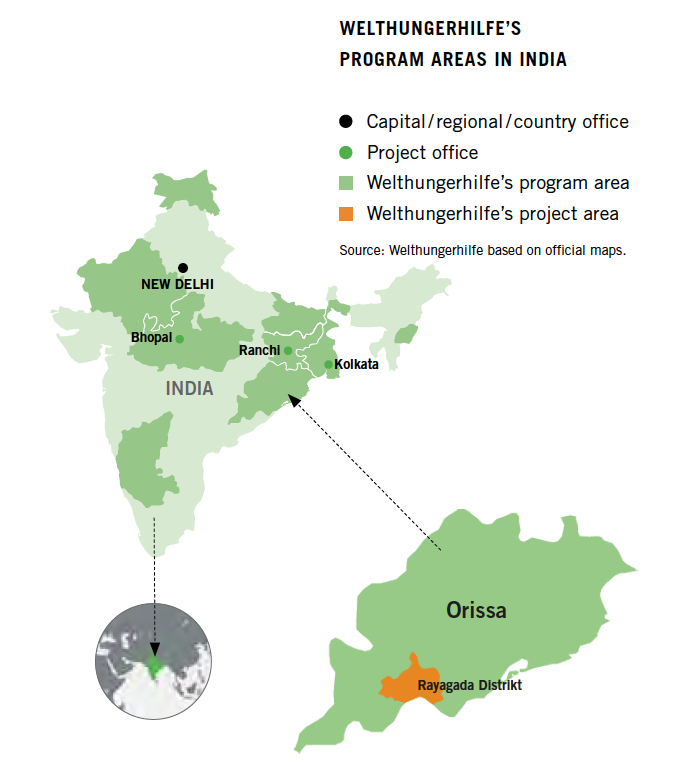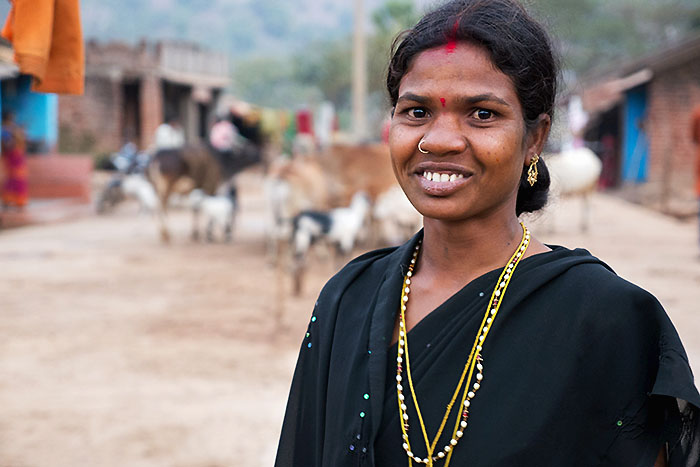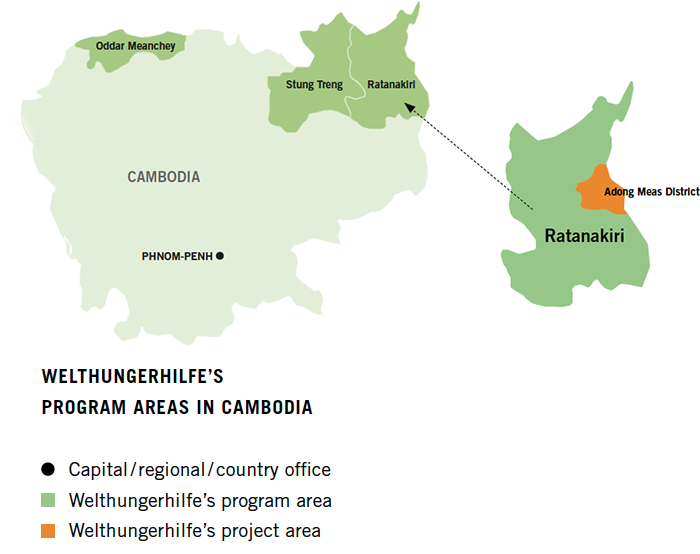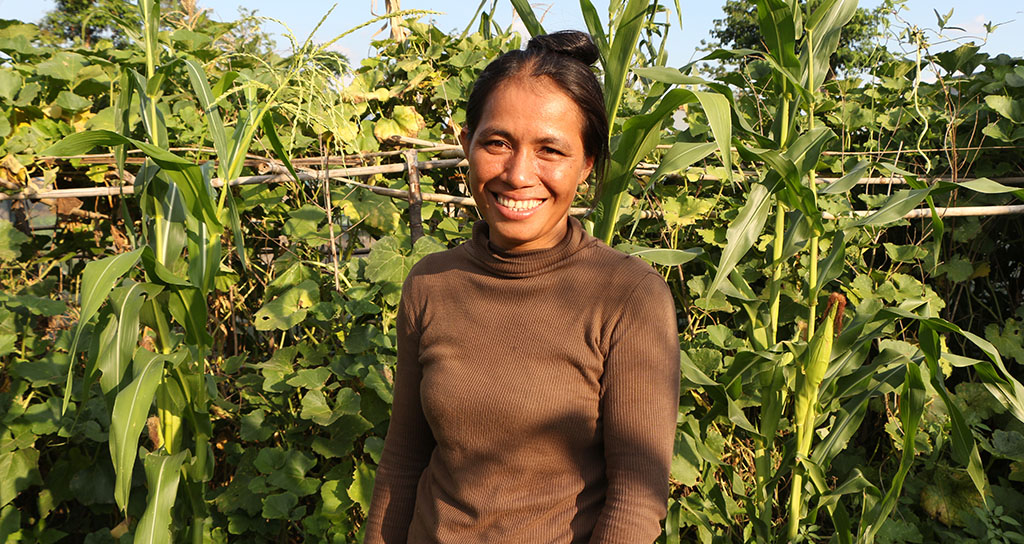Linking Agriculture, Natural Resource Management and Nutrition in Asia
Note: This case study was prepared by Welthungerhilfe and reflects this organisation's views and analyses, which have not been peer-reviewed by IFPRI’s Publications Review Committee and cannot be attributed to IFPRI.
Any citation of results or statements from this case study or the 2014 case study by Welthungerhilfe should follow this format: Welthungerhilfe and Concern Worldwide. 2014. “Integrated Approaches toward Improved Nutrition Outcomes,” Ch. 4 in von Grebmer et al. (eds.) 2014 Global Hunger Index: The Challenge of Hidden Hunger. Bonn, Washington, D.C., and Dublin: Welthungerhilfe, International Food Policy Research Institute, and Concern Worldwide.

India and Cambodia have shown promise over the past decade in reducing maternal and child mortality (UNICEF 2014b). In addition, India achieved a significant decrease in child underweight (India, Ministry of Women and Child Development, and UNICEF, India 2014).
However, there is still much room for improvement. Despite an improved 2014 Global Hunger Index ranking (55th), and an upgrade from the “alarming” to the “serious” category, India continues as home to the highest number of chronically malnourished (stunted) children under five: Nearly every second child is stunted (UNICEF 2014b). In Cambodia, ranked 43rd in the GHI, stunting affects 40 percent of the children under five.
Both countries produce enough food to meet the average calorie requirements of their populations (FAO 2014). Despite this fact, access to food is unevenly distributed and public policies still focus on quantity (energy supply) while investments in improving nutrition security such as improving the quality of diets and access to sanitation are lagging behind (IDS 2014; Results 2014). Anemia remains a critical public health problem affecting half of Cambodia's children under five and 70 percent of children under five in India (Cambodia 2013; IIPS and Macro International 2007). At the present rate of progress, both countries are unlikely to meet the Millennium Development Goals related to eradicating hunger and malnutrition, and improving maternal and child health (Cambodia 2013; India 2014).
To address undernutrition, in terms of lack of protein and energy, and the micronutrient deficiencies that affect particularly the rural poor and marginalized people, Welthungerhilfe applies a community-based training approach known as Linking Agriculture, Natural Resource Management and Nutrition (LANN) in its programs.
Research literature notes that traditional agricultural and income generation programs are not enough to improve nutrition and that potential synergies between the sectors have been underused (Lancet 2008; 2013). In 2009, Welthungerhilfe worked with an NGO network in Laos and jointly developed an integrated food-based training approach to reduce high levels of undernutrition in tribal communities in remote areas with low access to public health services, high levels of illiteracy, and a high dependency on wild food. The approach promotes linkages between small-scale agriculture, income-generating activities, natural resource management, and nutrition. So far it has been applied to Welthungerhilfe programs throughout Southeast and South Asia benefitting 26,000 households, or almost 130,000 people.
LANN’s long-term objective is to change behaviors and foster better family nutrition. As a community-based training approach it can be integrated into livelihood and food security interventions which aim for greater alignment of sectors to maximize their nutritional impact.
Establishing Good Nutrition Practices
To improve knowledge and practices related to good nutrition, the approach uses participatory learning. Women’s groups assess their family situations and learn about the vicious cycle of malnutrition where malnourished mothers give birth to underweight children who are likely to become stunted and face a greater risk of delivering low birth-weight babies themselves. Thus, malnutrition passes from one generation to the next if this cycle is not broken.
The training further highlights the different elements of a healthy diet throughout the life cycle, personal and domestic hygiene, techniques to limit nutrient losses during food storage and preparation, and appropriate maternal and childcare practices to ensure proper child growth and maternal health. Furthermore, families learn to make informed spending decisions that give priority to nutrient-rich foods rather than sweets, sweetened beverages, snacks, and alcohol.
Theater, role playing, and cooking demonstrations help the villagers realize the importance of good nutrition for their well-being as well as validate and share traditional knowledge on how to prepare highly nutritious locally available food. As women face multiple forms of discrimination and at the same time play a crucial role in safeguarding nutrition and caregiving, they are the main targets for awareness raising and empowerment.
However, the participation and support of men are vital as well. In the Rayagada District of Orissa, the project area of Welthungerhilfe´s Indian partner, Living Farms, for example, men have begun to play a critical role at the village level in opposing early marriage of girls, according to progress reports. In addition, together with their mothers, men do the work of their pregnant wives to allow them to rest.
Enhancing the Availability of and Access to Nutritious Food
Box 4.3
Emerging threats to traditional diets
“The traditional crops like different types of millets, pulses, and oilseeds, which were part of our regular diet and very nutritious, are now disappearing from the villages due to the government’s introduction of rice and other hybrid crops. In addition, the younger generation nowadays feels collecting and consuming food from the forest is humiliating. So community members are being forced to eat only Public Distribution System rice, which does not contain enough vitamins and minerals. We used to be much healthier when we ate traditional diverse foods.” Minati Tuika
 Minati Tuika, a peasant farmer from the village of Katalipadar, Orissa, India.
Minati Tuika, a peasant farmer from the village of Katalipadar, Orissa, India.
Rice dominates the diets of people in Cambodia and most of India. As the next harvest draws near, household stocks become depleted and increasing demand pushes prices higher. As a result, poor families are the first to cut down on their food consumption — especially by reducing spending on micronutrient-rich foods which are more expensive than staples. Other factors such as reduced availability of traditional crop varieties and their low status when compared with “modern foods” also limit nutritious food options (Box 4.3).
Home and school gardens can increase the availability of vegetables and fruits rich in vitamins and minerals, such as green leafy vegetables, jackfruit, mangos, moringa, papaya, pumpkins, and sweet potatoes. Uncultivated forest foods (for example, bamboo shoots, ferns, mushrooms, and fruit), make up to 40 percent of the local food basket of the indigenous target groups in Welthungerhilfe's project areas in India (Rayagada District of Orissa) and Cambodia (Ratanakiri province) (Box 4.4 below).
These foods are highly nutritious, rich in beta-carotene, vitamins, calcium, iron, and protein. To raise awareness of the importance of protecting and conserving such foods, project staff help the village people document the varieties and encourage them to share their food preparation knowledge. Raising small livestock such as chicken and fish provides essential animal-source nutrients like vitamin B12 and iron, plus high quality proteins. In addition, the support for agroecological or integrated farming practices such as traditional millets-based mixed cropping (combining cereals, pulses, oilseeds, and vegetables) is expected to reduce the dependence on single crops, shorten the lean periods, and increase household dietary diversity and family incomes through the sale of surpluses.

Creating an Enabling Environment for Nutrition
Combining food-based strategies with behavior change communication and support for a healthy environment addresses the underlying causes of malnutrition, including hidden hunger. But in the long term, people cannot break out of the vicious cycle of poverty and malnutrition unless basic rights, such as adequate access to productive resources, including land and income, as well as education and health services are met and related public services are put in place. At training and group meetings, community-based organizations are empowered to hold policy-makers and local administration accountable and demand improvements in the reach and quality of services.
The villagers of Rayagada district now use community score cards and social audits, introduced by Welthungerhilfe´s Indian partner Living Farms, to monitor service delivery by local governments in the health and education sectors. In addition, the health staff are trained to improve the quality of their services providing counseling, check-ups, supplements, deworming, and immunization to pregnant women and their children. Women are encouraged to regularly use these services.
Effects on Nutrition
While it is too early to provide comprehensive evidence of the approach’s impact on reducing malnutrition, availability of and access to different micronutrient-rich food items and household dietary diversity have increased. Preliminary data suggest a significant decline in waterborne diseases since improved water sources and latrines became available in the targeted villages and people began using better hygiene practices.
Exclusive breastfeeding during a child’s first six months has increased and complementary feeding has improved in quality and frequency. More women receive regular check-ups, counseling, and iron and folic acid supplements. Women have a higher level of self-confidence and more actively participate in decision-making at the household and community level.
However, while enhanced nutrition knowledge is possible in the short and medium term, achieving behavioral change for better family nutrition is a long-term process. To improve nutritional outcomes, the Linking Agriculture, Natural Resource Management and Nutrition approach connects interventions from different sectors with better nutrition, thereby helping to reduce micronutrient deficiencies.
Conclusion
The challenge of micronutrient deficiency is complex. Particularly in countries facing a high burden of malnutrition, hidden hunger goes hand in hand with other forms of malnutrition and cannot be addressed in isolation. Experience shows that any sustainable solution to hidden hunger will require a comprehensive and integrated approach toward balanced diets and healthy environments, with multiple sectors joining efforts and planning in a more coordinated way.
The programs highlighted in this chapter outline the approaches that Concern and Welthungerhilfe are pursuing and show that the response to the challenge of hidden hunger will require a sustained, long-term effort and the capacity and commitment to bring effective interventions to scale. Leveraging the complementary expertise of different ministries and sectors and offering the local community targeted training and support programs will help improve the nutritional status of individuals and communities. While further evidence is needed on how agriculture can improve and contribute to nutritional outcomes and which interventions or combinations will be the most effective, much can be done right now to alleviate hidden hunger.
Recent years have seen tremendous political will and commitment in the area of undernutrition, but it is vital that governments, policymakers, and all stakeholders follow through to ensure these commitments deliver results.
